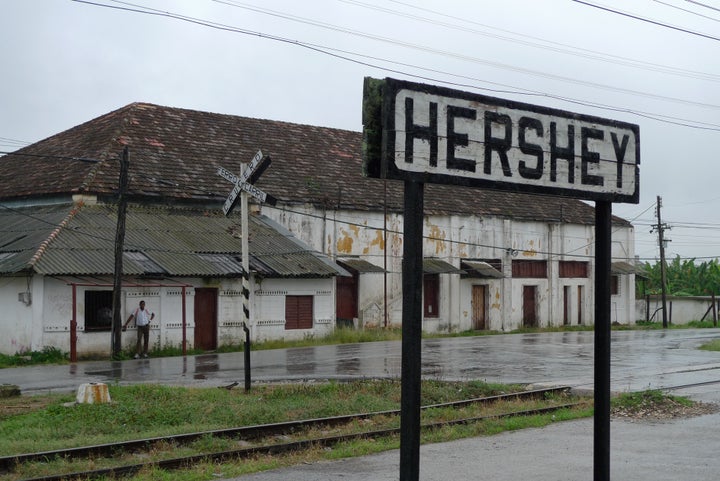
WASHINGTON -- Whatever their expectations were for their big summer in America, hundreds of young students from Eastern Europe and Asia wound up working on their feet all day in a chilly Pennsylvania plant, packaging Hershey candies for shipment, at a wage that some of them say wasn’t enough to break even on their journey.
The students' high-profile walkout last week and its subsequent uproar have prompted a State Department investigation into allegations that the working conditions were exploitative. But the CEO of the nonprofit that brokered the students' J-1 visas said in an interview that the jobs weren’t all that bad -- and that if they were, the students had been given fair warning of what the work would entail.
"The vast majority of them are having a wonderful experience," Rick Anaya, CEO of the Council for Educational Travel USA (CETUSA), said of the workers at the Hershey plant. "I think that the job is fine for the kids. I think it's good for the kids to see and learn that this is how a factory runs in the United States."
The students had been employed by a subcontractor twice removed from Hershey, and when asked about the working conditions, all the companies who’ve benefited from the students' work have foisted the responsibility on CETUSA, which arranged for the students to be here. An advocacy group called the National Guestworker Alliance has submitted a formal request to the State Department asking that it revoke its sponsorship of CETUSA, which, according to Anaya, helped bring 6,000 guest workers into the country this summer, in states from Florida to Alaska.
Anaya said that his nonprofit ended up "at the bottom of the pile," and that the pileup was instigated by American labor organizers who've been working with the most vocal of the disgruntled students.
"I personally think the kids are being misled by the National Guestworker Alliance and the AFL-CIO," Anaya said. "For some reason they've chosen to target this program. [The students] are being led astray."
Labor organizers certainly appear to be "stirring the pot," as Anaya says. But their interest in a bunch of kids from Moldova and Turkey is no mystery. For worker advocates, the Hershey controversy helps shed light on the gradual disappearance of good factory jobs in America, thanks to corporate cost-cutting and outsourcing. The use of student guestworkers, many believe, is one way for companies to undercut quality union jobs and strong living wages.
Last year more than 300,000 students participated in the J-1 program, which was designed to give kids from overseas a taste of America while filling some holes in the labor supply. While the staffing companies that provide workers to plants like Hershey's would presumably have little interest in cultural exchange, they would certainly have an interest in finding a cut-rate workforce, particularly during peak seasons like summer.
As in-depth reports have shown, despite its good intentions, the J-1 program has ended up supplying corporations with vast pools of cheap temp workers lacking benefits, many of whom have little grasp of their rights and the expectations of the American workplace. Job placement is widely known to be a crapshoot. Some kids end up pretty happy working boardwalk jobs in beach towns like Ocean City, Md., where the meager pay is offset by summer fun. But other kids land less desirable jobs in far-flung locales.
Indeed, as Anaya says, the students who came to Pennsylvania had apparently been warned that they wouldn’t be taking on America's most glamorous jobs.
One typical job offer, which CETUSA included in its defense to the State Department, notes that the "fast paced environment" at the plant would include "lots of bending, lifting and repetitive work"; that workers would be standing for the entire 8-hours shift; that they would often be lifting 50-pound loads; and that the temperature inside the factory would be set at a cool 59 degrees.
All told, the description hardly suggests a Wonka-like wonderland.
"It is helpful to have previous experience doing repetitive work with hands and arms," it warns.
But Saket Soni, the director of the National Guestworker Alliance, says the job description didn't begin to convey what he calls an exploitative arrangement, including constant work, verbal abuse from supervisors, and the threat of deportation.
"These students were promised a cultural exchange," Soni said in an email. "Instead, they became captive workers, pushed every day beyond their physical limits, trapped by crushing debt they had no chance to pay back, facing constant threats of deportation when they asked for the most elementary improvements in conditions."
The minimum pay rate was noted as $8.10 per hour, 85 cents above the federal minimum wage, amounting to a salary of about $16,000. Plenty of American workers would figure such money isn’t worth the drudgery, which is perhaps how foreign students wind up with jobs.
Despite the tedium and low pay, Anaya said the vast majority of the students look back on a positive experience, including those who work at the Hershey plant.
"A lot of these kids will go back to their country and manage factories," he said. "This will be a great experience. They'll learn what it's like to be in a factory."
The Hershey plant has been a popular destination for students in the past few years, Anaya said. But as of last week, the company that runs the Hershey plant has asked its temp staffing firm not to use J-1 students anymore, in light of the walkout. That left Anaya with some bad news to break to an agency in Thailand. They were planning on sending 100 students to the temp firm this spring through CETUSA.
"Unfortunately, we won't be able to do that anymore," Anaya said. "We'll have to find other jobs for them."
This post has been updated with comment from Soni.
WATCH a video of the student guestworkers' walkout:
